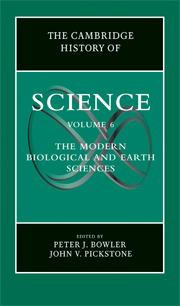Book contents
- Frontmatter
- 1 Introduction
- PART I WORKERS AND PLACES
- 2 Amateurs and Professionals
- 3 Discovery and Exploration
- 4 Museums
- 5 Field Stations and Surveys
- 6 Universities
- 7 Geological Industries
- 8 The Pharmaceutical Industries
- 9 Public and Environmental Health
- PART II ANALYSIS AND EXPERIMENTATION
- PART III NEW OBJECTS AND IDEAS
- PART IV SCIENCE AND CULTURE
- Index
- References
2 - Amateurs and Professionals
from PART I - WORKERS AND PLACES
Published online by Cambridge University Press: 28 November 2009
- Frontmatter
- 1 Introduction
- PART I WORKERS AND PLACES
- 2 Amateurs and Professionals
- 3 Discovery and Exploration
- 4 Museums
- 5 Field Stations and Surveys
- 6 Universities
- 7 Geological Industries
- 8 The Pharmaceutical Industries
- 9 Public and Environmental Health
- PART II ANALYSIS AND EXPERIMENTATION
- PART III NEW OBJECTS AND IDEAS
- PART IV SCIENCE AND CULTURE
- Index
- References
Summary
Science in the nineteenth century underwent major transformations. The immense growth of knowledge encouraged subdivision into increasingly narrow and self-contained areas of specialization. Science changed from an area of learning in which it was exceptional for people to be paid to pursue it into one in which large numbers were receiving instruction in schools and universities with the expectation of making their living from it. Science turned into a substantial profession, but the process of professionalization was not automatic. In most developed countries, there were conditions inimical to it, and when the change eventually took place, it did so comparatively abruptly and generated considerable tension. This compression has been a boon to historians, for it provides them with a clearly marked stratum dividing the preexisting world of science from the very different one that emerged shortly afterward.
THE PREPROFESSIONAL ERA
Until the 1880s, it is unhelpful and misleading to employ the categories “amateur” and “professional.” Whereas “amateur” has come to acquire a derogatory overtone, especially in the United States, it was the “professional” who was despised in the early nineteenth century. A professional was someone who received money to do something that others did for pleasure, and to put one’s labor up for hire placed one in the position of a servant. This aristocratic prejudice had trickled down into the upper middle class and restricted the range of occupations members of that class could follow.
- Type
- Chapter
- Information
- The Cambridge History of Science , pp. 13 - 33Publisher: Cambridge University PressPrint publication year: 2009
References
- 5
- Cited by

